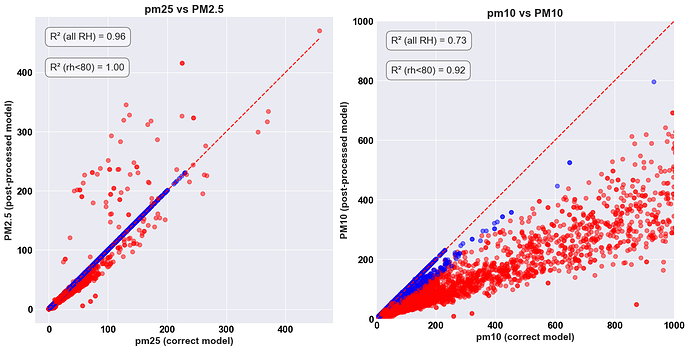Hi QuantAQ team,
I am analyzing data from ModulairPM. I was wanting to know the range of Hygroscopicity/kappa values used in the model to post process the data. I want to know this so that I can play with different Hygroscopic values from other instruments like AMS. I checked the documentation of the device and I found the sigmoid function graph for both kappa and density functions against diameter. But to replicate those graphs I would need some values like highest y axis value, x0 etc (basically more details on numbers required to re create those graphs). Can you please help me with this?
Hi Shivang,
You can get the values for your device by clicking on the device model page. To get there, navigate to the page for the sensor of interest and click on whichever model you’re interested in, in the lower right-hand side of the page. Let us know if you need more info and we can post a video or screenshot of where to find these.
Hi David,
Thank you for your reply. I searched it on QuantAQ website and my user page but could not find anything, can you please help in locating it?
Hey David, thank you. it helped. So I was able to capture the sigmoid functions for both kappa and density given in the technical notes. I am trying to post-process PM2.5 and PM10. I am taking PM1 from your final post-processed results and adding my results of PM2.5-1 and PM10-1 post-processed values. For some reason I am not able to capture PM2.5 and PM10 when RH is above 80%. I am underestimating them by a lot (when compared with your post-processed PM). Can you help me understand why is that the case? I mean do I need to add something to get the right values? This is important piece because there are lots of values with high RH days.
In this figure, x axis is your post-processed PM concentrations and y axis is mine. Red scatter is when RH>80%. R2 is 0.92 (for PM10) if I calculate it amongst PM10 values for when RH<80%.
new_bins[:, 1] = old_bins[:, 1] / (1 + kappa_mid * (rh / (100. - rh)))**(1./3.)
I am doing this for all RH values, and treating RH = 100% as 99.9%. I am wondering if something needs to be tweaked here for high RH values.
If you cannot disclose this because of your intellectual property rights, I will completely understand and would love if you could point me to right literature.
Hmm. Are you able to post the code you’re using? Are you applying the other corrections before or after adjusting the bin diameters?
Hi David,
I have sent you an email with complete python code I used to make our post-processing model. Thank you for helping, appreciate it
Hey @shivang I didn’t receive an email. Can you please send again to david.hagan@qaunt-aq.com. Thanks!
Hey David,
Just sent it to you now. Thank you for the follow up ![]()
